1996 CHEVROLET TAHOE brakes
[x] Cancel search: brakesPage 213 of 403
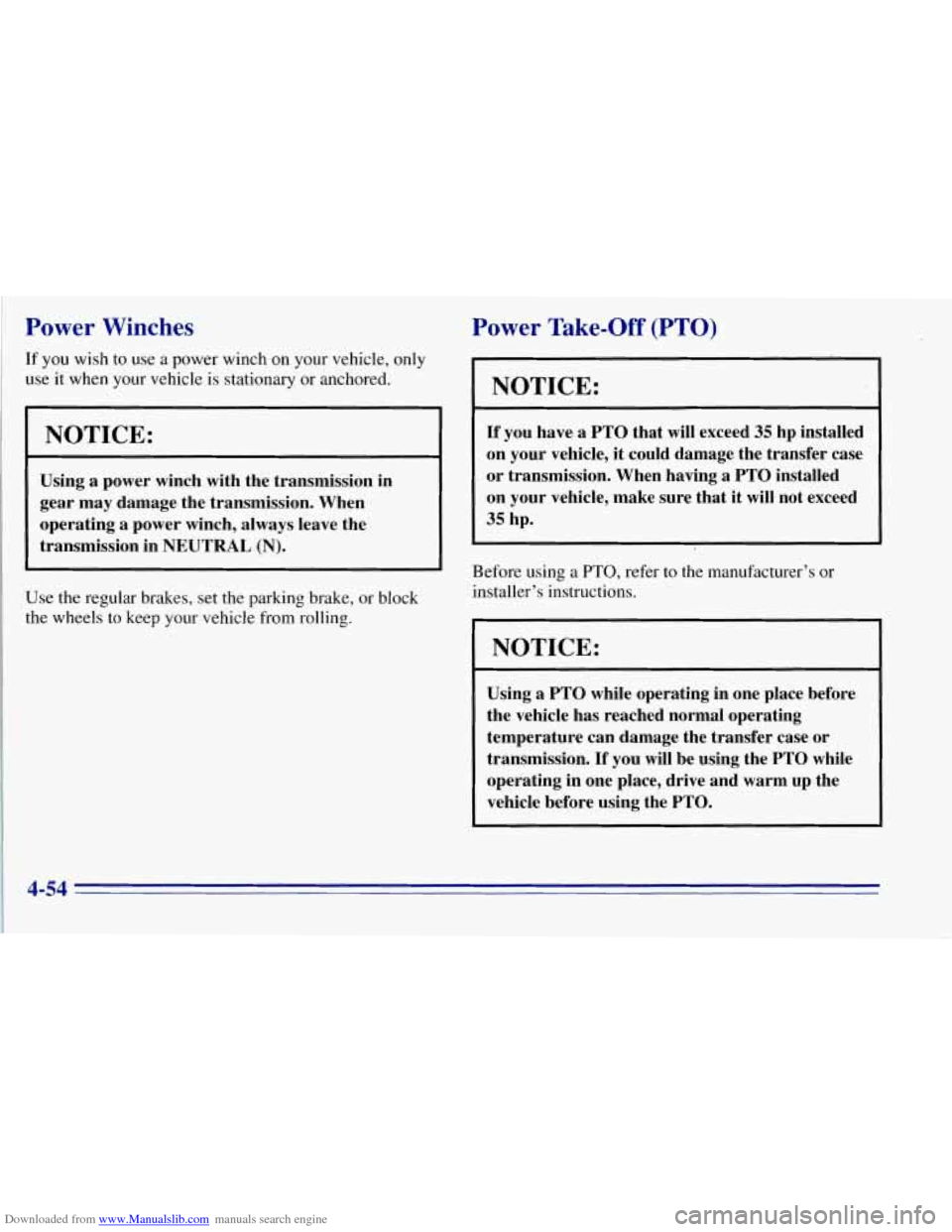
Downloaded from www.Manualslib.com manuals search engine Power Winches Power Take-Off (PTO)
If you wish to use a power winch on your vehicle, only
use it when your vehicle is stationary or anchored.
NOTICE:
Using a power winch with the transmission in
gear may damage the transmission. When
operating
a power winch, always leave the
transmission in NEUTRAL
(N).
Use the regular brakes, set the parking brake, or block
the wheels to keep your vehicle from rolling.
NOTICE:
If’ you have a PTO that will exceed 35 hp installed
on your vehicle,
it could damage the transfer case
or transmission. When having
a PTO installed
on your vehicle, make sure that
it will not exceed
35 hp.
Before using a PTO, refer to the manufacturer’s or
installer’s instructions.
NOTICE:
Using a PTO while operating in one place before
the vehicle has reached normal operating
temperature can damage the transfer case or
transmission. If you will be using the PTO while
operating in one place, drive and warm up the
vehicle before using the PTO.
4-54
Page 214 of 403

Downloaded from www.Manualslib.com manuals search engine To engage a PTO:
1. Set the parking brake.
2. Shift the transmission into NEUTRAL (N).
3. Hold the clutch pedal down and engage the PTO.
NOTICE:
Using a PTO for more than four hours without
driving your vehicle can damage the transfer case
or transmission. If using a PTO for more than
four hours without driving your vehicle, drive
your vehicle for a while
to allow the transfer case
and transmission to
cool.
If you are going to drive the vehicle, shift the
transmission into the,gear
you want. Then shift the
transfer case into the range
you want (if you have
four-wheel drive), apply the regular brakes and
release the parking brake.
4. Release the clutch (and the regular brakes) as you
normally would. When you release the clutch, the
PTO will start.
Using a Transfer Case Mounted PTO
1. Set the parking brake.
2. Shift the transfer case into NEUTRAL (N).
3. Shift the transmission into NEUTRAL (N).
4. Engage the PTO.
If you are going to drive the vehicle, shift the
transfer case into the range
you want. Then apply the
regular brakes and release the parking brake.
5. Shift the transmission to THIRD (3) to start the PTO.
6. Release the regular brakes to drive the vehicle.
4-55
Page 284 of 403
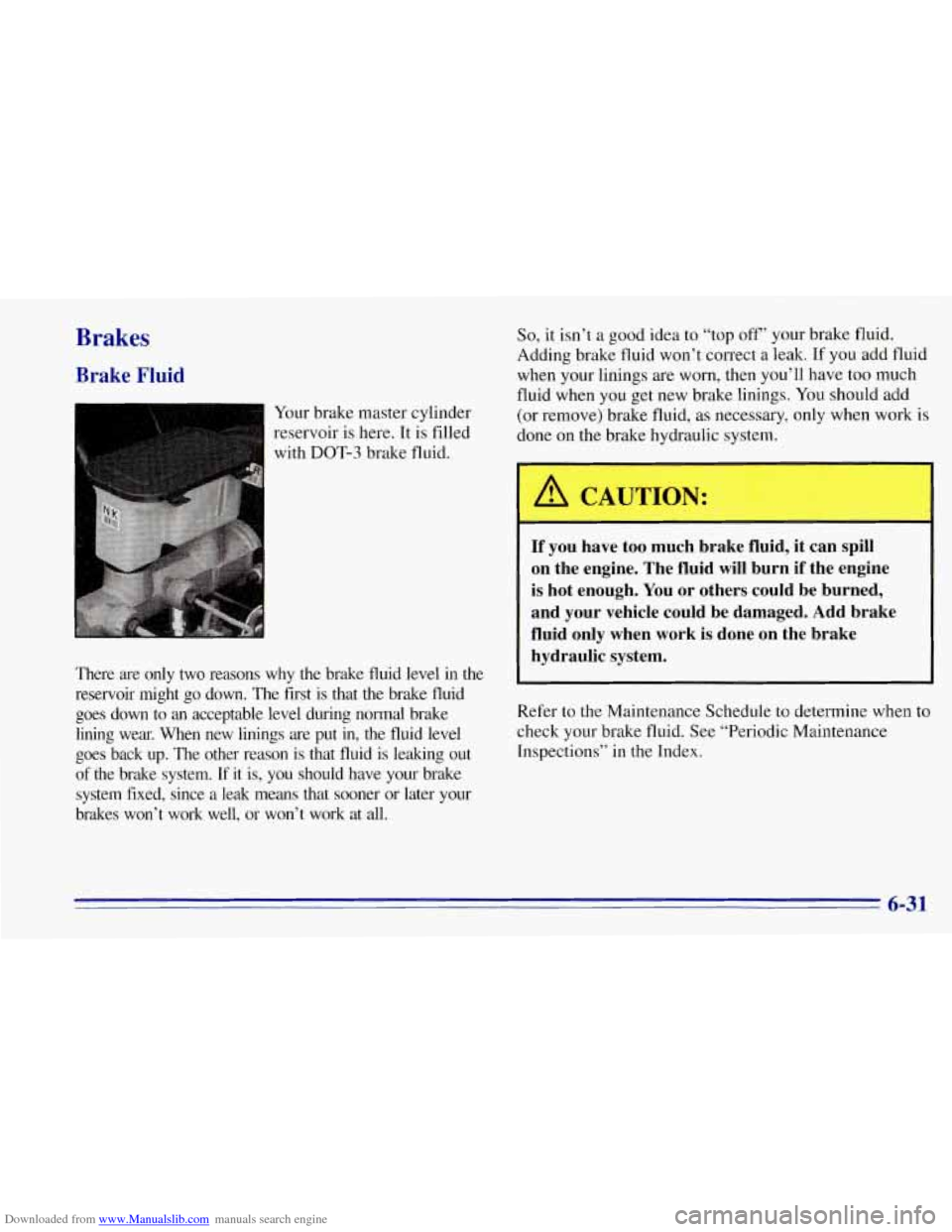
Downloaded from www.Manualslib.com manuals search engine Brakes
Brake Fluid
Your brake master cylinder
reservoir
is here. It is filled
with
DOT-3 brake fluid.
There are only two reasons why the brake fluid level in the
reservoir might go down. The first is that the brake fluid
goes down to an acceptable level during normal brake
lining wear. When new linings are put in, the fluid level
goes back up. The other reason is that fluid is leaking out
of the brake system. If
it is, you should have your brake
system fixed, since a leak means that sooner or later your
brakes won’t work well, or won’t work at all.
So, it isn’t a good idea to “top off’ your brake fluid.
Adding brake fluid won’t correct a leak. If you add fluid
when your linings are worn, then you’ll have
too much
fluid when you get new brake linings. You should add
(or remove) brake fluid, as necessary, only when work is
done on the brake hydraulic system.
-
-
If you have too much brake fluid, it can spill
on the engine. The fluid
will burn if the engine
is hot enough. You or others could be burned,
and your vehicle could be damaged. Add brake
fluid only when work is done
on the brake
hydraulic system.
Refer to the Maintenance Schedule to determine when to
check your brake fluid. See “Periodic Maintenance
Inspections” in the Index.
6-31
Page 285 of 403
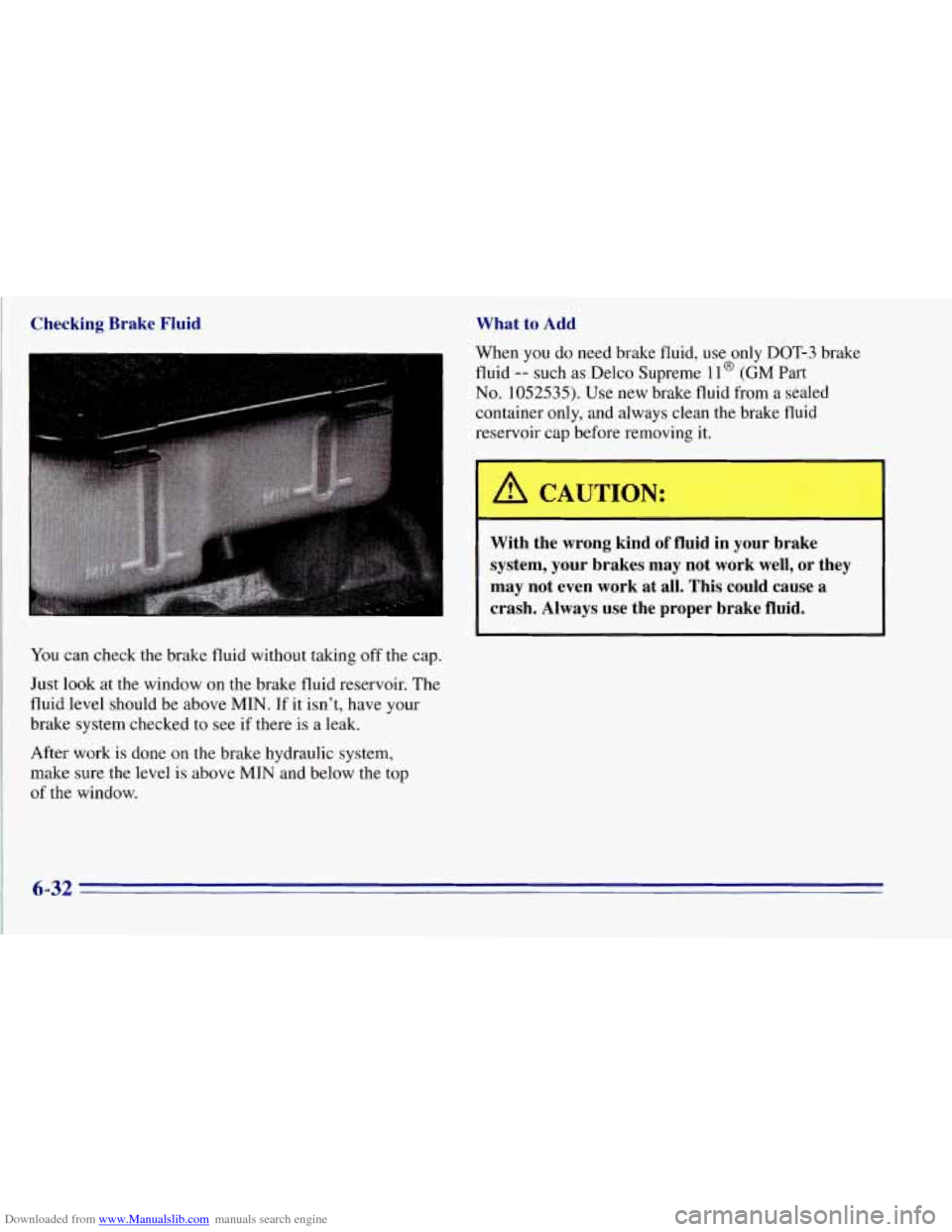
Downloaded from www.Manualslib.com manuals search engine Checking Brake Flu: What
to Add
When you do need brake fluid, use only DOT-3 brake
fluid
-- such as Delco Supreme 11 @ (GM Part
No. 1052535). Use new brake fluid from a sealed
container only, and always clean the brake fluid
reservoir cap before removing
it.
A CAUTION:
With the wrong kind of fluid in your brake
system, your brakes may not work well, or they
may not even work at all. This could cause a crash. Always use the proper brake fluid.
You can check the brake fluid without taking off the cap.
Just look at the window
on the brake fluid reservoir. The
fluid level should be above MIN. If it isn’t, have your
brake system checked to see if there is a leak.
After work is done on the brake hydraulic system,
make sure
the level is above MIN and below the top
of the window.
6-32
Page 286 of 403

Downloaded from www.Manualslib.com manuals search engine NOTICE:
Using the wrong fluid can badly damage
brake system parts. For example, just a few
drops of mineral-based oil, such as engine
oil, in your brake system can damage brake
system parts
so badly that they’ll have to be
replaced. Don’t let someone put in the
wrong kind of fluid.
If you spill brake fluid on your vehicle’s
painted surfaces, the paint finish can be
damaged. Be careful not to spill brake fluid
on your vehicle.
If you do, wash it off
immediately. See “Appearance Care’’
in the Index.
Brake Wear
Your vehicle has front disc brakes and rear drum brakes.
Disc brake pads have built-in wear indicators that make a
high-pitched warning sound when the brake pads are worn
and new pads are needed. The sound may come and go or
be heard all the time your vehicle is moving (except when
you are pushing on the brake pedal firmly).
-
r, CAUTION: I
The brake wear warning sound means that sooner
or later your brakes won’t work well. That could
lead to an accident. When you hear the brake wear
warning sound, have your vehicle serviced.
I
NOTICE:
Continuing to drive with worn-out brake pads
could result in costly brake repair.
.
6-33
Page 287 of 403
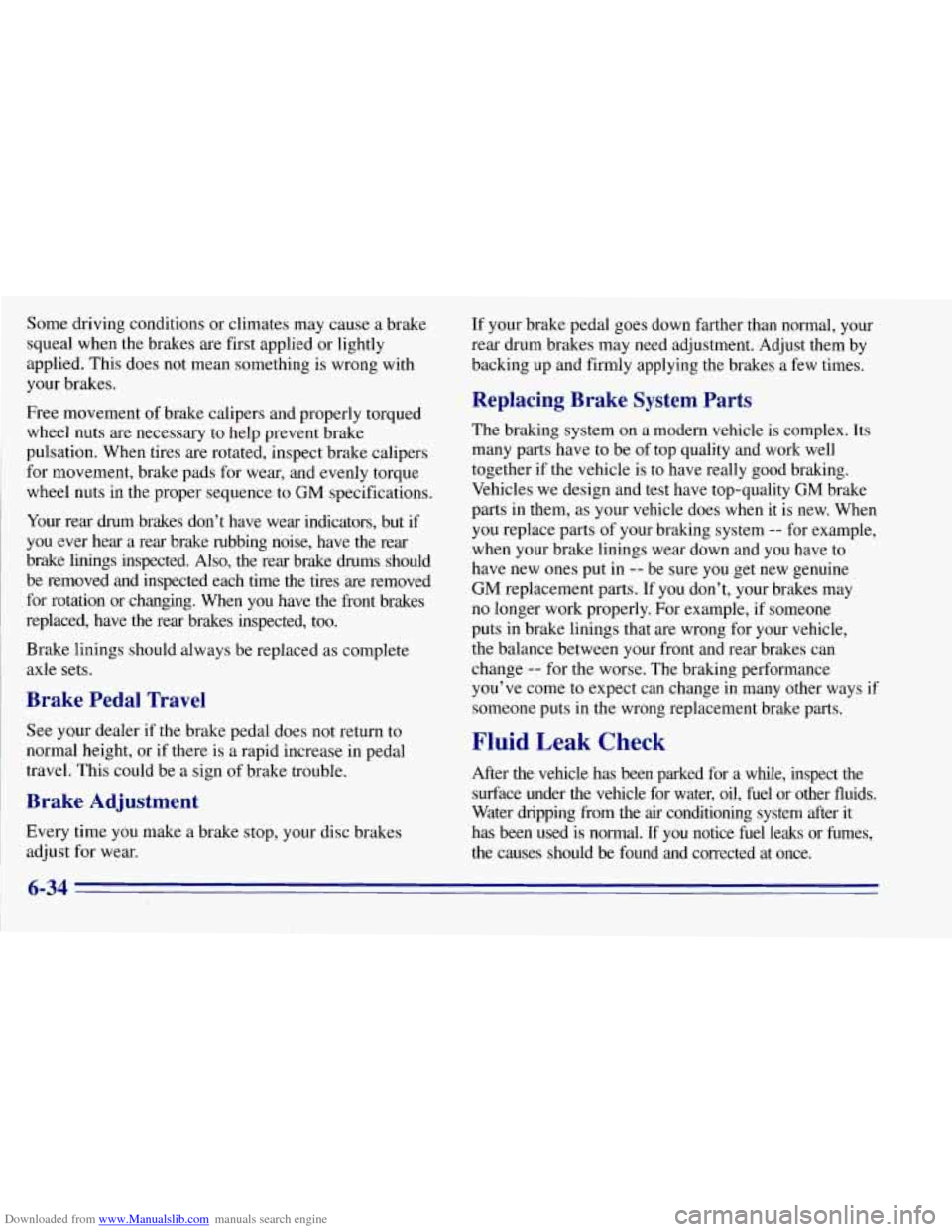
Downloaded from www.Manualslib.com manuals search engine Some driving conditions or climates may cause a brake
squeal when the brakes are first applied or lightly
applied. This does not mean something is wrong with
your brakes.
Free movement
of brake calipers and properly torqued
wheel nuts are necessary
to help prevent brake
pulsation. When tires are rotated, inspect brake calipers
for movement, brake pads for wear, and evenly torque
wheel nuts in the proper sequence to
GM specifications.
Your rear drum brakes don’t have wear indicators, but if
you ever hear a rear brake rubbing noise, have the rear
brake linings inspected. Also, the rear brake drums should
be removed and inspected each time the tires are removed
for rotation or changing. When you have the front brakes
replaced, have the rear brakes inspected, too.
Brake linings should always be replaced as complete
axle sets.
Brake Pedal Travel
See your dealer if the brake pedal does not return to
normal height, or
if there is a rapid increase in pedal
travel. This could be a sign of brake trouble.
Brake Adjustment
Every time you make a brake stop, your disc brakes
adjust for wear. If
your brake pedal goes down farther than normal, your
rear drum brakes may need adjustment. Adjust them by
backing up and firmly applying the brakes a few times.
Replacing Brake System Parts
The braking system on a modern vehicle is complex. Its
many parts have to be of top quality and work well
together if the vehicle is to have really good braking.
Vehicles we design and test have top-quality
GM brake
parts in them, as your vehicle does when it is new. When
you replace parts of your braking system
-- for example,
when your brake linings wear down and you have to
have new ones put in
-- be sure you get new genuine
GM replacement parts. If you don’t, your brakes may
no longer work properly. For example, if someone
puts in brake linings that are wrong for your vehicle,
the balance between your front and rear brakes can
change
-- for the worse. The braking performance
you’ve come to expect can change in many other ways if
someone puts in the wrong replacement brake parts.
Fluid Leak Check
After the vehicle has been parked for a while, inspect the
surface under the vehicle for water, oil, fuel or other fluids\
.
Water dripping from the air conditioning system after
it
has been used is normal. If you notice fuel leaks or fumes,
the causes should
be found and corrected at once.
6-34
Page 372 of 403

Downloaded from www.Manualslib.com manuals search engine Steering Column Lock Check
While parked, and with the parking brake set, try to turn
the key to LOCK
in each shift lever position.
The key should turn to LOCK only when the shift
The key should come out only in LOCK.
lever
is in PARK (P).
Parking Brake and Automatic Transmission
PARK (P) Mechanism Check
- -
When you are doing this check, your vehicle
could begin to move. You or others could be
injured and property could be damaged. Make
sure there is room in front
of your vehicle in case
it begins to roll. Be ready to apply the regular
brake at once should the vehicle begin to move.
Park on a fairly steep hill, with the vehicle facing
downhill. Keeping your foot on the regular brake, set the
parking brake.
'To check the parking brake: With the engine running
and transmission in NEUTRAL
(N), slowly remove ,
foot pressure from the regular brake pedal. Do this
until the vehicle is held by the parking brake only.
To check the PARK (P) mechanism's holding ability:
With the engine running, shift to PARK (P). Then
release all brakes.
7-45
Page 374 of 403
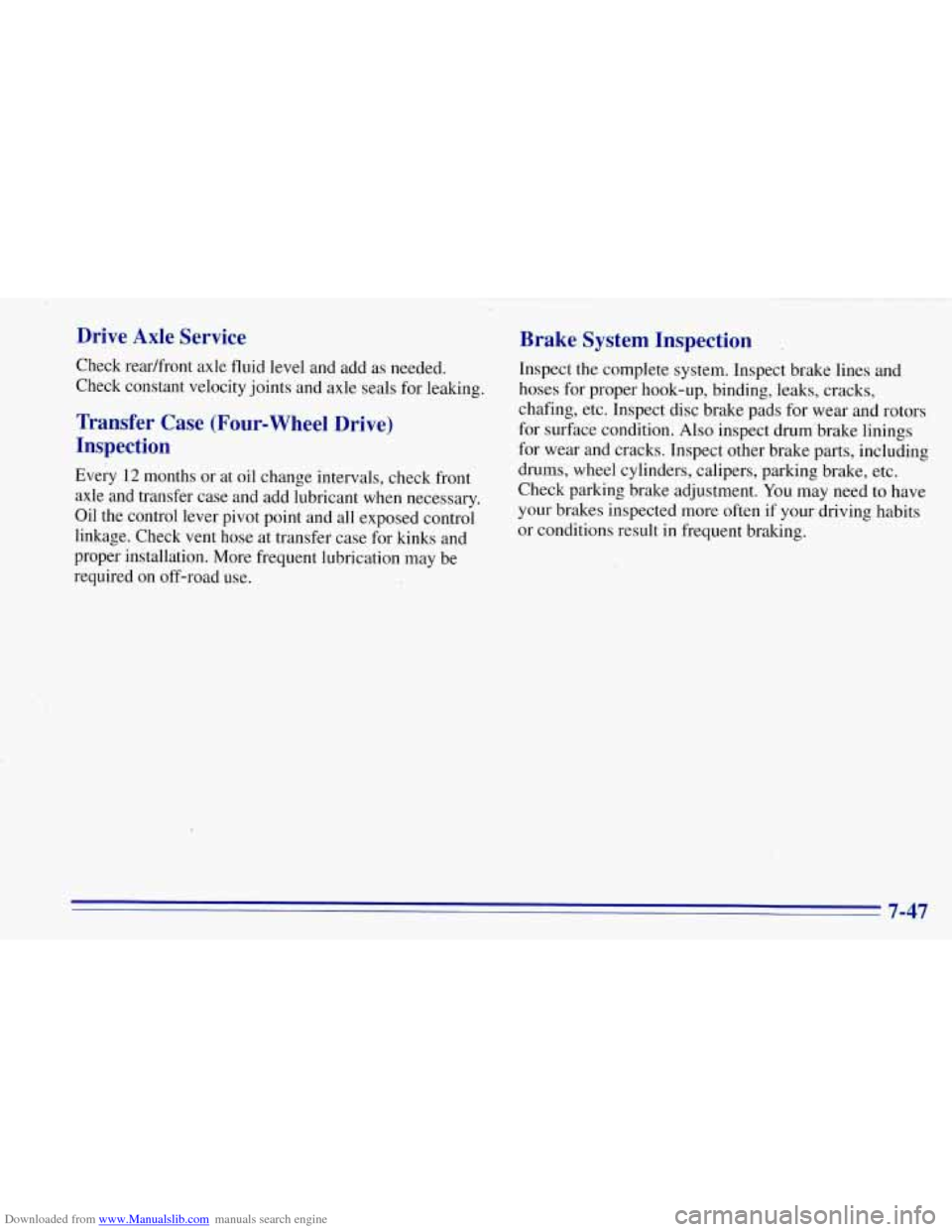
Downloaded from www.Manualslib.com manuals search engine Drive Axle Service
Check readfront axle fluid level and add as needed.
Check constant velocity joints and axle seals for leaking.
Transfer Case (Four-wheel Drive)
Inspection
Every 12 months or at oil change intervals, check front
axle and transfer case and add lubricant when necessary.
Oil the control lever pivot point and all exposed control
linkage. Check vent hose at transfer case for
kinks and
proper installation. More frequent lubrication may be
required on off-road use.
Brake System Inspection
Inspect the complete ,system. Inspect brake.lines and
hoses for proper hook-up, binding, leaks, cracks,
chafing, etc. Inspect disc brake pads for wear and rotors
for surface condition. Also inspect drum'brake linings
for wear and cracks. Inspect other brake parts, including
drums, wheel.cylinders, calipers, parlung brake, etc.
Check parking brake adjustment.
You may need to have
your brakes inspected more often
if your driving habits
or conditions result in frequent braking.
7-47